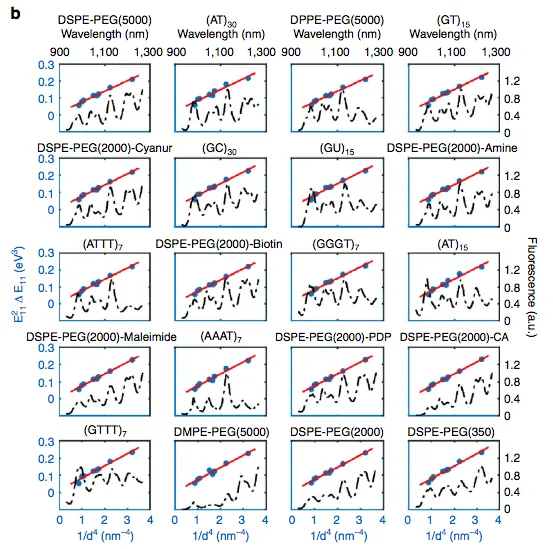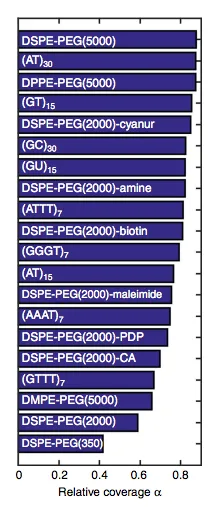Protein Corona Phase Molecular Recognition (CoPhMoRe)
This invention is applicable to any research-- industrial, medical, clinical, or otherwise-- that would require high-throughput screening with the goal of finding an optically active nanoparticle that is able to recognize a specific biological molecule. It can replace macromolecule detection methods and protein assays both in vitro and in vivo, such as ELISA or lateral flow strips, immunohistochemistry, and protein-resin binding, for real-time diagnostics. It can also be used therapeutically to block receptor-ligand interactions.
Researchers
-
protein corona phase molecular recognition
United States of America | Granted | 11,474,102
Figures
Technology
This invention introduces a novel synthetic recognition scheme for macromolecules that, unlike natural systems, is not constrained by cost or production scale and can withstand long-term storage. The synthetic recognizer is comprised of a single-walled carbon nanotube (SWCNT) with adsorbed heteropolymer on its surface. This is achieved through the dialysis of a surfactant-SWCNT suspension in the presence of the heteropolymer for wrapping exchange. The hydrophobic segments of the polymer are adsorbed onto the hydrophobic surface of the SWCNT. This pushes the hydrophilic portions into the surrounding solution, forming a corona phase that is unique to the configuration of the heteropolymer and capable of recognizing target analytes. Previous work has demonstrated that these sensors are capable of recognizing small molecules, such as riboflavin, L-thyroxine, and small neurotransmitters, and a recent screen has suggested that they are also capable of recognizing macromolecules. Of 14 protein analytes and 20 distinct SWCNT corona phases screened, a particular corona phase molecular recognition (CoPhMoRe) scheme using SWCNT suspended in a phospholipid-PEG construct was discovered to be capable of recognizing fibrinogen, a blood plasma macromolecule protein. Screening for binding was accomplished through detecting spectral changes corresponding to analyte binding, such as fluorescent intensity and emission wavelength modulation, both of which are fast and easy to perform. Atomic force microscopy, quartz crystal microbalance with dissipation measurements, and kinetic measurements all suggest that fibrinogen physically binds to the CoPhMoRe phase owing to a unique 3D interaction between the conformation of the corona phase and the fibrinogen molecule. Since even such a small screen was capable of identifying the strong binding specificity of a particular corona phase to a macromolecule, future screens will likely identify many other such interactions.
Problem Addressed
Currently, the most advanced, widely used molecular recognition schemes involve natural systems, including antibodies and aptamers. Natural recognition schemes are limited by the need for a living organism or by problems such as degradation, instability, cost, and production scale that natural recognition schemes face. Synthetic recognition schemes such as molecular imprinting have been able to recognize small molecules, but no method for identifying macromolecules has been successful.
Advantages
- High specificity macromolecule recognition
- Fast screening for macromolecule binding to corona phase
- Applicability to in vivo and in vitro screening assays and therapeutics
- Stable, cost-effective, and mass-producible
- Can be applied to small molecule recognition as well
Publications
Bisker, G., Dong, J., Park, H., et al. "Protein-targeted corona phase molecular recognition." Nature Communications 7 (2016): 10241. doi: 10.1038/ncomms10241.
License this technology
Interested in this technology? Connect with our experienced licensing team to initiate the process.
Sign up for technology updates
Sign up now to receive the latest updates on cutting-edge technologies and innovations.

![The structure of the phospholipid-PEG constructs used in this study to suspend the SWCNT. (i) DPPEPEG(5000), (ii) DMPE-PEG(5000), (iii) DSPE-PEG(5000), (iv) DSPE-PEG(2000), (v) DSPE-PEG(2000)-Cyanur, (vi) DSPE-PEG(2000)-carboxylic acid (CA), (vii) DSPE-PEG(2000)-Maleimide, (viii) DSPE-PEG(2000)-[3-(2-Pyridyldithio)-propionyl] (PDP), (ix) DSPE-PEG(2000)-Amine, (x) DSPEPEG(2000)-Biotin, (xi) DSPE-PEG(350). The number in parentheses is the molecular weight of the PEG chain in Daltons](/sites/default/files/styles/800w/public/images/Screen_Shot_2016-04-16_at_10.23.03_AM.png.webp?itok=LDsoIjs4)

